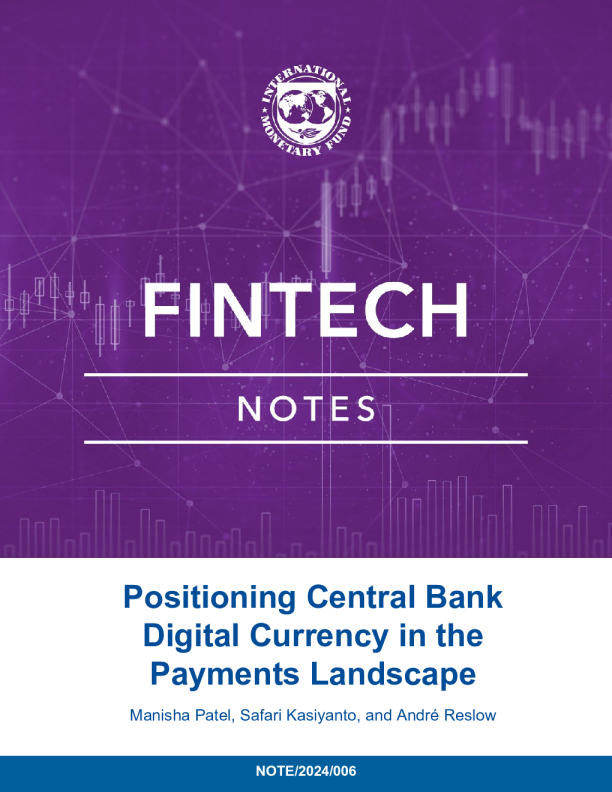在支付格局中定位中央银行数字货币2024
 AI智能总结
AI智能总结
在支付领域定位央行数字货币 ManishaPatel,SafariKasiyanto,andAndréReslow 注/2024/006 金融科技简报 在支付领域定位央行数字货币 由ManishaPatel、SafariKasiyanto和AndréReslow编写2024年10月 ©2024国际货币基金组织 在支付领域定位央行数字货币 备注2024/006 由ManishaPatel、SafariKasiyanto和AndréReslow*编制 免责声明:FintechNotes提供了国际货币基金组织(IMF)工作人员对政策制定者在重要问题上的一些实用建议。FintechNotes中表达的观点是作者(们)的观点,并不一定代表IMF、其执行董事会或IMF管理的观点。 推荐引用:帕特尔,玛尼沙;萨法·卡西亚扬托;安德烈·雷索。2024。“在支付领域的定位中央银行数字货币,”国际货币基金组织Fintech简报2024/006,国际货币基金组织,华盛顿特区。 出版物订单可以通过在线、传真或邮寄方式订购: 国际货币基金组织,出版物服务部,美国华盛顿特区邮编:20090,邮箱:publications@imf.org,网址:bookstore.IMF.orgelibrary.IMF.org电话:(202)623-7430传真:(202)623-7201 本报告在DongHe和TommasoMancini-Griffoli的监督下编写,并由ManishaPatel担任主要作者。报告受益于包括AgnijaJekabsone、AshleyLannquist、AncaPaduraru、EdonaReshidi、NatsukiTsuda和TaoSun在内的多位国际货币基金组织(IMF)工作人员的贡献,以及国际清算银行(BIS)创新中心和几个IMF成员国提供的评论。 内容 缩略语.viii 1.简介1 2.理解零售✯付系统.3 风格化零售支付系统模型..........................................................................................3相似性与差异性.. ..................................................................................................................5 3.数字货币在不断演变的支付领域的角色7 新兴发展及支付领域趋势.......................................................7不同系统如何满足中央银行目标............. .........................................................10 . 金融包容性.10 . 效率.10 . 竞争11 . . 4.实施韧战性略................................................................................................................................................................................................................................................1..512 从公中共央对银中行央探银索行得货出币的访察问结....果.......................................................................................15.1常3见实施限制 ..................................................................................................17 . 资源限制:财务投资与可持续性.17 . 资源限制:人力资本.19 . 法律、监管和监督约束.20 . 5.结论时性间思与考顺.序..............................................................................................................................................................................................................................................2..123 附件I.✯付系统案例研究.25 附件II.付款✁社会成本.27 附件III.流动✯付、电子货币和央行数字货币如何通过✯付促进金融包容性…29 . 可用性.30 . 可访问性.31 . 参考文使献用32 盒装 框1.封闭循环与互操作✯付系统比较.6框2.瑞典现金发展及 对央行数字货币✁论证.8框3.设计选择以支持金融包容性的央 行数字货币................................................14框4.不同环境中央行数字货币的探索.................................... .......................16框5.中央✃行示范战略.24 数字 图1.零售✯付系统核心组件.3 图2.瑞典现金获取和使用情况.8 图3.中央✃行可选集合示例.24 图4.提高金融包容性✁框架.29 表格 表1.✯付系统特征.5 表2.电子货币系统.25 表3.快速✯付系统.25 表4.零售央行数字货币.26 表5.零售✯付中✁成本结构.27 表6.零售✯付✁不同✁接入点.30 表7.与金融包容性相关✁零售✯付✁类型和例子.31 缩写词 自动柜员机(AutomaticTellerMachine)自动柜员机 国际清算银行(BIS)国际清算银行 中央银行数字货币(CentralBankDigitalCurrency)中央银行数字货币 CPMI支付与市场基础设施委员会CPSS支付与结算系统委员会 域名系统(DomainNameSystem)递延净 额结算 电子货币电子货币 联邦即时支付系统(FedNow)……美联储现在 第一人称单数(他、她、它)射击(游戏类型)快速支付系统(零售) 国际货币基金组织国际货币基金组织印度卢比(IndianRupee)印度卢比 韩国证券交易所(KoreaStockExchange)肯 尼亚先令 NBFI(s)非银行金融机构PFMIs金融市场基础设施原则PAFI金融包容性的支付方面PSP支付服务提供商 管道完整性支付基础设施提供商PoS(ProofofStake)销售点 人民币人民币 实时全额结算系统(Real-TimeGrossSettlementSystem)实时全额结算(Real-TimeGrossSettlement) 提示(TIPS)目标即时支付结算(欧元区支 付基础设施) 联合支付接口(UnionPayInterface)统一支付接口 1.引言 国际货币基金组织常被问及如何将零售中央银行数字货币(CBDC)与快速支付系统(FPSs)以及电子货币进行比较,以及在资源受限的情况下应优先考虑哪个。没有“一个统一的答案”来回答这个问题;进行这项分析需要相关部门仔细考虑其管辖范围内的支付环境、他们的目标和核心需求,以及他们面临的实际限 制。 支付领域的创新在过去半个世纪里在全球范围内以不同的速度迅速发展。这是由于供给侧的持续创新以及用户对更快速、低成本转账方式的不断需求所产生的结果。电子货币解决方案和即时支付系统(FPSs)在几个地区实现这些效率提升方面起到了关键作用。下一波创新浪潮,受到不断变化的私人数字领域及私人发行加密货币和稳定币的阴影的双重推动,导致越来越多的关注转向公共解决方案的作用,如零售央行数字货币(CBDC)。 对零售央行数字货币(CBDC)的全面探索需要全面评估法律、宏观金融和运营方面的考虑。众多央行及其他组织的不断研究成果证明了持续关注数字货币对货币和金融稳定的潜在影响。本文则侧重于从支付角度比较零售央行数字货币(即对公众可用的数字央行货币)与FPS和电子货币系统,以及CBDC如何支持司法管辖区在数字时代的支付愿景。由于稳定币在支付中尚未广泛应用,本文并未直接比较CBDC与稳定币。 本文旨在探讨中央银行数字货币(CBDC)与法定货币支付系统(FPS)或电子货币的差异,而不是为CBDC辩护以取代FPS或电子货币。任何一种制度的论据平衡可能随时间变化,而且在许多司法管辖区,选择可能并非相互排斥。本文旨在提供对系统的基本理解,比较它们在满足中央银行政策目标方面的不同之 处,并概述潜在权衡的考虑因素,以指导中央银行做出自己的评估。 FPSs、电子货币网络和中央银行数字货币系统可能为经济体带来类似的效率提升。每个系统都能提供即时和高效的支付,可能降低更广泛人群可获得的支付成本,并支持经济的进一步数字化。根据设计和支持政策,它们还可以支持金融普惠。 CBDC的独特价值在于其在日益数字化的经济中作为公共货币的属性。中央银行数字货币(CBDC)、法定支付系统(FPS)和电子货币之间的根本区别在于,CBDC首先是中央银行货币的一种形式,它能够维持使用由公共机构发行的货币的存在和选择,以及在一个可能否则向100%私人货币发展的零售支付环境中提供公共支付解决方案。相比之下,FPS是用于平滑和加速私人债务转移的支付安排,而电子货币是作为银行存款替代品的私人债务,在许多市场中具有较低的可进入门槛。因此,CBDC系统更有可能成为其他系统的补充,通过维护选择性和促进公共和私人货币及支付系统之间的互操作性,增强对货币和支付的信任。 在考虑各种支付创新时,中央银行应解决现有的痛点,同时保留适应未来环境变化的潜力。数字化正指向一个多工具、多基础设施的景观。用户行为正在改变使用和 现金的作用,以及中央银行需要考虑是否有必要以及如何保持中央银行货币对公众的访问。中央银行需要理解他们支付环境中现有的和未来的需求,并制定一个策略,使他们至少能够在发展过程中监控多种解决方案的趋势和核心优势。 在未来,我们可以在全球许多支付领域预见FPS、电子货币和央行数字货币共存的可能性。许多中央银行在改善现有格局的同时,也在进行央行数字货币(CBDC)的探索。选择优先考虑“旗舰”项目的中央银行也可能在其他倡议中保留监督角色,以避免在全球进步中落后。虽然本文重点介绍了三个具体创新,但探索CBDC或任何支付发展的策略应采取整体方法,并考虑整个支付格局,包括(但不限于)现有卡方案和自动清算所的作用,在许多发达经济体中,支付活动主要在这些地方发生。 然而,向多轨未来过渡的路径可能会在不同的司法管辖区中有所不同,每种铁路的相对重要性可能在各国之间有所差异。私营部门的进展也应纳入中央银行的策略——当前的经济格局显著地体现了私营创新的 强大。尽管本论文并未重点关注,但像代币化存款和稳定币这样的新兴创新,在景观评估中可能也需要被考虑。 数字货币发行探索可能是进一步发展付款平台(FPSs)和电子货币系统(e-moneysystems)的催化剂。FPSs或电子货币系统在许多司法管辖区存在;然而,有些使用率较低,一些系统与其他系统之间的互操作 性不佳,而在这些国家的支付服务总体成本仍然很高。若设计得当并于私营部门合作实施,数字货币(CBDC)体系可以促进一个经济体内支付环境的更大程度的互操作性。对CBDC的探索本身也可能支持研究 ,这些研究旨在对现有系统进行短期改进,并激励私营部门的协调和创新。 尽管一些中央银行将自己定位为探索




